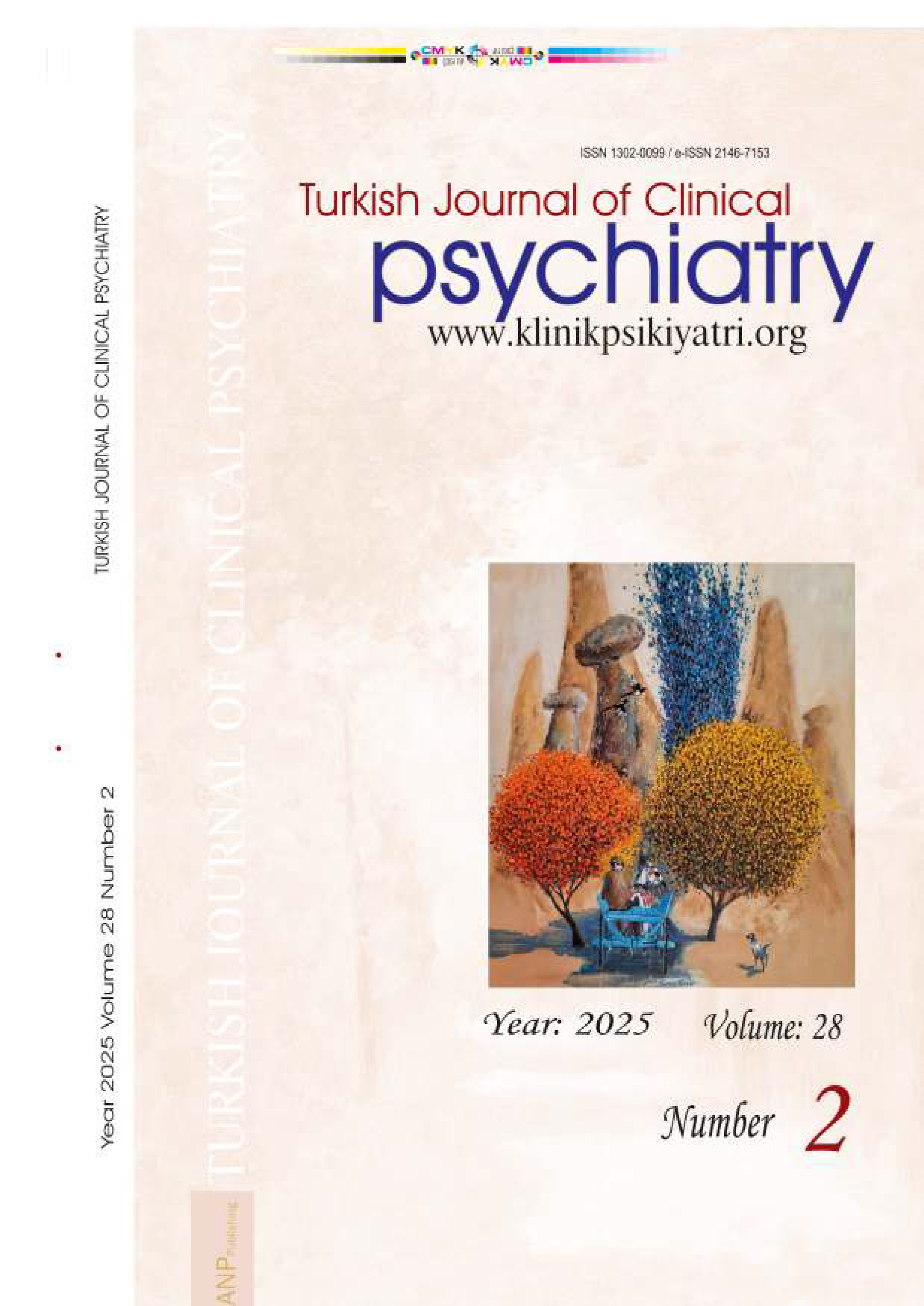





Volume: 25 Issue: 4 - 2022
| EDITORIAL | |
| 1. | Re-discussing Turkey's mental health structure: Where are we going? (tur) Burhanettin Kaya doi: 10.5505/kpd.2022.75508 Pages 348 - 349 Abstract | |
| RESEARCH ARTICLE | |
| 2. | Assessment of retinal findings in children and adolescents with specific learning disorder: A case-control study (eng) Aziz Kara, Okan Ağca doi: 10.5505/kpd.2022.34545 Pages 350 - 355 INTRODUCTION: Specific Learning Disorder; is a neurodevelopmental disorder that arises due to genetic, epigenetic and various environmental factors. The aim of this study is to compare children and adolescents diagnosed with specific learning disorder with healthy controls in terms of intraocular pressure, retinal nerve fiber layer, central macular thickness and choroidal thickness. METHODS: This prospective case-control study included 63 children and adolescents, including 30 with specific learning disabilities and 33 controls. The case and control groups were assessed using ‘Schedule for Affective Disorders and Schizophrenia School-Age Children-Present and Lifetime Version Form-DSM-5 Turkish Version for diagnostic interview. Case and control groups were compared in terms of retinal findings by performing intraocular pressure and optic coherence tomography. In the study, various retinal nerve fiber layer quadrants were compared separately for the right and left eyes. RESULTS: In the case group, only the right eye superior nasal retinal nerve fiber layer quadrant thickness was found to be lower than the control group. There was no difference between the groups in terms of other parameters. DISCUSSION AND CONCLUSION: Our study indicates a lower right eye superior nasal retinal nerve fiber layer quadrant thickness in children and adolescents with specific learning disorder as compared to controls. However, there was no difference between the groups in terms of intraocular pressure and other retinal findings. Longitudinal studies with larger samples are needed in order to generalize retinal findings in specific learning disorder to the population. |
| 3. | Attention deficit hyperactivity disorder in elderly individuals: Prevalence and clinical features (tur) Şilan Şenbayram Güzelbaba, Lut Tamam, Mehmet Emin Demirkol, Zeynep Namlı, Mahmut Onur Karaytuğ, Caner Yeşiloğlu doi: 10.5505/kpd.2022.26042 Pages 356 - 365 INTRODUCTION: Attention Deficit Hyperactivity Disorder (ADHD)’s clinical appearance of the older adults is different from that of children and young adults. The diagnosis is generally missed in older ages or patients are exposed to polypharmacy due to misdiagnoses. This situation causes deterioration in functionality and financial burden. Our study aims to determine the frequency and clinical features of ADHD in the elderly. METHODS: We included 70 individuals aged 65 and over, who admission in our outpatient clinic as the clinical sample, and 70 healthy volunteers as the control group who had similar sociodemographic characteristics with the clinical sample. We diagnosed ADHD with Wender Utah Rating Scale (WURS) and Adult ADHD Self-Report Scale (ASRS) scores, family interviews, and psychiatric interviews. We used DSM-5 Structured Clinical Interview-Clinical Version (SCID-5-CV) to identify additional diagnoses and Barratt Impulsivity Scale (BDI-11) to evaluate impulsivity. RESULTS: The prevalence of childhood ADHD (C-ADHD) was 26%, and adult ADHD (A-ADHD) was 11% among the clinical sample. The prevalence of C-ADHD was %4.2, and there was no A-ADHD in the control group. The BIS-11-motor subscale score was significantly higher in those with A-ADHD than those without in the clinical sample (p=0.04). The BIS-11-total and all subscale scores were significantly higher with C-ADHD than those without C-ADHD in the clinical sample (p<0.05 for each). DISCUSSION AND CONCLUSION: This study suggests that individuals with a previous psychiatric diagnosis have a higher rate of ADHD diagnosis compared to the healthy population, and ADHD often accompanies mood disorders and anxiety disorders. There may be a cause-effect relationship between ADHD and other mental disorders or similarities in the etiopathogenesis. Questioning ADHD symptoms in clinical samples over 65 years of age will contribute to determining the correct diagnosis and appropriate treatment. |
| 4. | Psychological resilience and impulsivity in trichotillomania and skin picking disorder (tur) Efruz Pirdoğan Aydın, Hasan Demirci, Jülide Güler Kenar, Ömer Akil Özer, Oğuz Karamustafalıoğlu doi: 10.5505/kpd.2022.78466 Pages 366 - 375 INTRODUCTION: In this study, our aim is to compare patients diagnosed with skin picking disorder (SPD) and trichotillomania (TTM) with healthy controls in terms of psychological resilience and to examine the relationship between psychological resilience levels and impulsivity. METHODS: Patients diagnosed with SPD (n=43) and TTM (n=34) according to the DSM-5 diagnostic criteria, and 46 age, gender and educational status matched individuals as the control group were included in our study. A sociodemographic data form, Beck Depression Inventory (BDI), Beck Anxiety Inventory (BAI), Clinical Global Impression Scale (CGI), Barratt Impulsivity Scale (BIS), and Resilience Scale for Adults (RSA) were administered to the participants. RESULTS: In the ANCOVA analysis performed by fixing depression and anxiety scores, TTM patients had significantly lower levels of psychological resilience compared to SPD patients and the control group (respectively p=0.002, p=0.001). There were significant negative correlation between the resilience of TTM patients and their depression and impulsivity scores (R²=0.441, F=7.882, df=3, p=0.001). There was a significant negative correlation between resilience and depression scores of patients with SPD (R²=0.345, F=6.860, df=3, p=0.001).Conclusion: TTM patients had low levels of psychological resilience. Impulsivity and depression scores of TTM patients and depression scores of DYB patients negatively have affected on resilience levels. Improving of coping strategies with stress and enhancing support systems should be contained among therapeutic interventions since TTM and SPD patients have low psychological resilience levels. DISCUSSION AND CONCLUSION: TTM patients had low levels of psychological resilience. Impulsivity and depression scores of TTM patients and depression scores of DYB patients negatively have affected on resilience levels. Improving of coping strategies with stress and enhancing support systems should be contained among therapeutic interventions since TTM and SPD patients have low psychological resilience levels. |
| 5. | The effect of emotional dysregulation on functionality in euthymic patients diagnosed with bipolar I disorder (tur) Gözde Akbaba, İbrahim Balcıoğlu doi: 10.5505/kpd.2022.76736 Pages 376 - 385 INTRODUCTION: There is an intense loss of functionality in bipolar disorder both in mania or depressive periods and in euthymic periods. The study aims to determine effect of emotion regulation difficulties on functionality in adults in euthymic period diagnosed with bipolar disorder type I (BP-I). METHODS: Thirty-six patients with BP-I and control group of 40 persons, matched in terms of age, gender, educational status, were formed. The Difficulties in Emotion Regulation Scale (DERS) was used to assess current and clinically significant difficulties related to emotion regulation, and the Functional Assessment Short Test (FAST) was used to assess functionality. RESULTS: There were no significant differences between patient and control groups in terms of total score of DERS (p=0.422), Nonacceptance (p=0.870), Goal-directed behaviour (p=0.488), Impulse (p=0.220), Awareness (p=0.098), Strategies (p=0.682), Clarity (p=0.263) subscale scores of DERS scale, Wender Utah Rating Scale total score (p=0.261), and Hamilton Anxiety Rating Scale total score (p=0.766). Although the FAST total score was similar in both groups (p=0.558), in the BP-I group in terms of subscale scores, autonomy (p=0.010), cognitive functionality (p=0.048), financial issues (p=0.004) and leisure time activities (p=0.007) scores were statistically significantly higher than the control group. In the patient group, there was a significant positive correlation between the FAST total score and the DERS strategies subscale (r=0.338, p=0.044). Weak-to-moderate significant positive correlations were found between different subscales of FAST and DERS; those were ccupational functionality (FAST) and non-acceptance (DERS); cognitive functionionality (FAST) with goals, strategies, and clarity (FAST); financial issues (FAST) and awareness (DERS); leisure activities with goals (FAST) and awareness (DERS). DISCUSSION AND CONCLUSION: It should be aimed to improve the psychosocial functionality levels after the illness periods; it is concluded that it would be beneficial to improve emotion regulation difficulties in the euthymic period, which is associated with impaired functionality, by using appropriate treatment methods. |
| 6. | The variables predicting the length of hospital stay and within one year recurrent admission in psychiatric disorders with psychotic symptoms: A retrospective study (tur) Çiğdem Geniş, Muhammed Hakan Aksu, Behcet Coşar doi: 10.5505/kpd.2022.61224 Pages 386 - 394 INTRODUCTION: In this study, we aimed to investigate the variables that predict the length of hospital stay and recurrent admission within one year after discharge in psychiatric disorders with psychotic symptoms. METHODS: The study was conducted with the data of patients who were treated in the inpatient department of the psychiatry department of XXX University between 2005-2016. Psychiatric disorders with psychotic symptoms were included in the study. ICD-10 was used as the basis for diagnosis. A total of 1670 data of patients were included in the analysis, including 1301 single admission and 369 recurrent admission. Only the initial admission record data of the patients were used in the analysis. RESULTS: Significant variables that prolong the duration of hospital stay are schizophrenia diagnosis (β=0.186), female gender (β=-0.129), depression diagnosis (β=0.106), recurrent admission (β=0.099), diagnosis of schizoaffective disorder (β=0.055), and advanced age (β=0.053). 33.9% of patients with recurrent admission were readmitted within the first year. Variables predicting recurrent admission in the first year after first admission in patients with psychotic symptoms are, in order of importance; The absence of a diagnosis of schizophrenia (OR=0,368, p=0,002), a short hospital stay (OR=0,981, p=0,007) and no diagnosis of schizoaffective disorder (OR=0,333, p=0,011). DISCUSSION AND CONCLUSION: Although the diagnosis of schizophrenia and schizoaffective disorder are predictors that prolong hospital stay, they are significant predictors that reduce recurrent admission. Although the presence of these disorders may seem contradictory at first glance, the prolonged hospital stay may prevent the re-hospitalization of these disorders in the first year. Although this is a prediction, the decrease in recurrent admission as the length of hospitalization supports this prediction. The relationship between the length of stay and recurrent hospitalization in psychiatric disorders accompanied by psychotic symptoms, especially schizophrenia and schizoaffective disorder, should be considered in further studies. |
| 7. | Clinical characteristics and forensic psychiatric examination of cases evaluated due to alleged psychiatric medical malpractice (tur) Ender Cesur, İlker Taşdemir, Ercan Büyükakıncak, Hızır Asliyüksek, Şenol Turan doi: 10.5505/kpd.2022.33716 Pages 395 - 403 INTRODUCTION: The aim of the study is to evaluate the forensic medical dimension of medical malpractice lawsuits filed against health personnel working in the field of psychiatry, to investigate which health workers are complained about, what are the damages that occur in cases where medical malpractice is detected, and in which processes the detected errors occur. METHODS: In the study, the reports of 122 cases with claims of medical malpractice concerning psychiatry, which were evaluated by the Council of Forensic Medicine between 2013 and 2020, were examined retrospectively through sociodemographic and clinical forms. RESULTS: 42 (34.4%) of the examined files were made against healthcare professionals working in training and research hospitals and 34 (27.9%) in public hospitals. 113 of the personnel involved in the incident were physicians (92.6%). Psychiatry specialists were in the first place among the physicians with alleged faults. Considering the death status of the cases, it was seen that 65 (53.3%) resulted in death. 19 cases died due to suicide (29.2%). In our study, it was seen that the most important cause of defect in the cases found to be physician error was diagnosis and report mismatch. DISCUSSION AND CONCLUSION: The increasing workload and responsibilities of healthcare professionals and the decrease in the time allocated to patients can damage the trust between the physician and the patient, which paves the way for medical practice errors or possible claims. Increasing studies on this subject will contribute to the prevention of claims of medical malpractice and to minimize these errors. |
| 8. | Burnout syndrome in medical faculty students (tur) Ayşe Zeynep Akkoyun, Elif Aksu, Zeynep Eker, Hilal Mutlu, Mustafa Uyar, Burak Taylan Göbekci doi: 10.5505/kpd.2022.47587 Pages 404 - 415 INTRODUCTION: In this study, it was aimed to show the level of burnout and the factors related to burnout in Afyonkarahisar Health Sciences University School of Medicine students. METHODS: Data; sociodemographic data form was collected through Maslach Burnout Inventory, Beck Depression Inventory, Beck Anxiety Inventory and Beck Hopelessness Inventory. The burnout level of medical students was first examined within the framework of personal and demographic variables. Afterwards, the sample was divided into two groups as preclinical (grades 1, 2 and 3) and clinical (grades 4, 5 and 6). The relationship between burnout and depression, anxiety and hopelessness levels was investigated between the groups and in the whole sample. RESULTS: The results of the analysis showed us the following: There are significant differences in terms of burnout according to the variables of gender, age, class, frequency of going to the hometown, choosing the faculty, living with whom and the average daily amount of sleep. In addition, significant relationships were found between the sub-dimensions of burnout and the levels of depression, anxiety and hopelessness. Among these parameters, depressive symptoms were found to be associated with burnout at a higher level. In addition, no significant difference was found in any area of burnout between the preclinical and clinical groups. DISCUSSION AND CONCLUSION: Our study determined that the burnout levels of medical students are high. It is thought that this study contributed to revealing the factors that lead doctor candidates to burnout. |
| CASE REPORT | |
| 9. | A case report of adolescent anti-NMDAR encephalitis with depressive symptoms (eng) Onur Tuğçe Poyraz Fındık, Gulten Öztürk, Hakkı Akbeyaz, Sermin Aksoy Özcan, Olcay Ünver, Dilşad Türkdoğan, Nese Perdahli Fis doi: 10.5505/kpd.2022.83436 Pages 416 - 419 Clinical presentation of anti-N-methyl-D-aspartate receptor (anti-NMDAR) encephalitis includes both neurological and psychiatric symptoms, and it is diagnosed with autoantibodies against the GluN1 subunit of NMDAR. The clinical presentation has a wide range of non-specific symptoms such as rapidly progressing psychiatric symptoms, cognitive impairment, seizures, and abnormal movements. The fact that mental and behavioural symptoms play an important role in the course of this rare clinical disorder complicates the differential diagnosis with psychiatric disorders and may lead to a delay in treatment. This case report presents the diagnostic process, treatment, and follow-up of an adolescent diagnosed with anti-NMDAR encephalitis. Neurological examination of a 15-year-old adolescent girl with sudden onset of contractions in the trunk and extremities were within normal limits when her symptoms started. Sertraline was prescribed since these were considered to be associated with new-onset depressive symptoms. She was admitted to the emergency department because of her exacerbated facial dyskinesias after using sertraline for one week. During clinical follow-up of the patient, no psychotic findings were observed, but amnesia, cognitive slowing, suicide attempts, and physical aggression were psychiatric symptoms that were difficult to manage. Psychiatric symptoms improve after switching to rituximab and regressed totally, still asymptomatic in the second year of treatment. Anti-NMDAR encephalitis usually occurs in adolescence and young adulthood. Psychiatric symptoms complicate the diagnosis. Since early intervention is a positive prognostic marker, it is important to raise clinician awareness of this particular clinical picture. |
| 10. | Amnestic disorder associated with Kluver Bucy syndrome after HSV encephalitis: A case report (tur) Neslihan Kara, Enes Sarıgedik, Ahmet Ataoğlu doi: 10.5505/kpd.2022.59244 Pages 420 - 425 Encephalitis is an infection of the brain parenchyma and herpesviruses, enterovirular and paramyxoviruses are among the causes of viral encephalitis. Herpes Simplex Virus is one of the most common causes of encephalitis. It usually occurs in elderly and immunocompromised individuals. Herpes Simplex Virus shows rapid onset in the acute phase and has a severe course. It often giving signs of encephalitis such as weakness, sensory abnormalities, aphasia and visual field loss. Herpes Simplex Virus encephalitis causes behavioral, emotional, personality and memory disorders depending on the involvement of inflammatory and necrotic areas, although there are differences in the affected brain regions, the severity of neurological damage and cognitive impairments. In case of suspicion by clinical signs, imaging and cerebrospinal fluid findings, acyclovir treatment should be started and if seizures are present, they should be controlled. Amnestic disorders are a syndrome in which instant memory is preserved, with severe impairment in learning new information and impaired recall of previously learned information. Herpes Simplex Virus encephalitis is among the causes of amnestic disorder. Kluver Bucy Syndrome is a rare syndrome seen in bilateral temporal lobe damage and characterized by visual agnosia, hypersexuality, emotional behavior changes, placidity, hyperorality and hypermetamorphosis. In this case, a 52-year-old female patient who developed Amnestic Disorder accompanied by Kluver Bucy Syndrome after Herpes Simplex Virus encephalitis, which is a rare condition, is presented. |
| 11. | Guillain-Barre like syndrome associated with risperidone use: A case report (eng) Güneş Devrim Kıcalı doi: 10.5505/kpd.2022.70846 Pages 426 - 429 Guillain-Barre Syndrome is an autoimmune response that usually occurs due to infectious or idiopathic causes. Rare case reports have also been shown to be caused by the intake of many substances and drugs. GBS cases results in 10% mortality and 25% respiratory failure. This case report describes the occurrence and termination of GBS-like syndrome following first time risperidone intake at a patient in the psychiatric ward. A 42-years old female patient without any prior psychiatric history admitted to psychiatric ward with paranoid and persecutory delusions, disorganized speech and behaviors related to systematic delusions aiming infidelity of her spouse. Risperidone 4 mg day prescribed for treatment for first time. In seventh day, neuromuscular symptoms started as dizziness, ataxia, muscle weakness and ascending paralysis. Neurological examination and consultation, imaging and lumbar puncture was performed, resulting GBS diagnosis. With the immediate transfer to intense care unit, Risperidone treatment stopped and hIG treatment administered. Patient Recovered without any physical impairment. Current case presents a GBS like syndrome associated with Risperidone treatment. There are several Atypical antipsychotic drug treatment related GBS like case reports but this is the first to be associated with Risperidone in adults. Infection related etiology was excluded by patient history but no specific antibody test or immunological survey was performed for GBS. |
| 12. | Succesful ECT treatment of a treatment resistant manic bipolar patient with intracranial mass and pulmonary embolism history: Case report (eng) Anıl Muştucu, Rümeysa Ayşe Güllülü, Salih Saygın Eker doi: 10.5505/kpd.2022.59320 Pages 430 - 433 Electroconvulsive therapy (ECT) is an effective and safe treatment method used in many psychiatric disorders. The efficacy and safety of ECT in the presence of an intracranial mass is controversial. The presence of a space-occupying mass was a contraindication to ECT until the 1980s. With the changes in ECT protocols over time and its application to more patients, positive data on the safety of ECT in intracranial masses have begun to accumulate. Available data suggest that ECT can be safely used in patients with benign, small, and otherwise clinically insignificant tumors. A history of pulmonary embolism (PE) accompanying a psychiatric disorder may cause clinicians to avoid ECT. There are some concerns regarding the use of ECT in patients with a history of PE as there is little evidence for the safety of the implementation of ECT. Although there is limited evidence regarding the safety of ECT in the presence of comorbidities, ECT can be successfully implemented where there is no response to other treatments with the necessary consultations and close follow-up, without delaying the treatment. In this article, a case who had been followed up with a bipolar affective disorder diagnosis, was hospitalized for manic episode, who had comorbidities such as intracranial tumor and PE history, who did not benefit from psychotropic treatments and who responded significantly to nine sessions of ECT without any complications is presented. The case presented here is, as far as is known, the first report where comorbidities such as intracranial tumor and pulmonary embolism history, which may cause clinicians to hesitate to implement ECT, co-exist. |
| 13. | An adult case suggestive of pediatric autoimmune neuropsychiatric disorders associated with streptococcal infection (PANDAS) diagnosis (tur) Sare Aydın, Ahmet Ekrem Savaş, Esma Akpınar Aslan, Sedat Batmaz doi: 10.5505/kpd.2022.16768 Pages 434 - 440 Pediatric autoimmune neuropsychiatric disorders associated with streptococcal infection (PANDAS) describe a picture with obsessive-compulsive symptoms and tics in childhood as a result of autoimmune response after group A-beta hemolytic streptococcal infection. PANDAS is a syndrome which progresses with various symptoms in childhood and is difficult to diagnose, and in which a significant regression in neuropsychiatric symptoms is observed with early detection and treatment of infection. In this article, a 21-year-old case with psychiatric symptoms exacerbated by recurrent infections and suggesting the diagnosis of PANDAS is presented. Undiagnosed and untreated PANDAS is at high risk for lifelong development of obsessive compulsive disorder and tic disorder. Patients who are thought to have a diagnosis of PANDAS should be referred to the appropriate center without delay and treatment should be started. |










